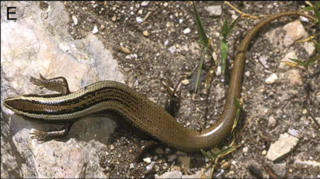
Skinks are lizards belonging to the family Scincidae, a family in the infraorder Scincomorpha. With more than 1,500 described species across 100 different taxonomic genera, the family Scincidae is one of the most diverse families of lizards. Skinks are characterized by their smaller legs in comparison to typical lizards and are found in different habitats except arctic and subarctic regions.

Spondylurus powelli, the Anguilla Bank skink, was discovered in the Caribbean with 20 other reptile species and was immediately listed as an endangered species. The population of this lizard has been decreasing due to the introduction of the mongoose, which was originally imported to control rats in sugarcane fields, and now is an invasive species to the Caribbean Islands. Many of the newly added skink species discovered along with S. powelli are facing extinction for the same reason. Skinks are unique and perhaps at a disadvantage among lizards as they produce a human-like placenta and have live birth. The average gestation period is suggested at one year and may be the cause for the skinks being an easy target to the mongoose, since they are larger and slower when pregnant. Other types of human activity, along with the deforestation in the Caribbean, are thought to have decreased overall species numbers, as well.

Spondylurus is a genus of lizards in the family Scincidae. The genus Spondylurus, vernacularly known as the Antillean four-lined skinks, is a neotropical skink taxon including many species.

Mabuyinae is a subfamily of skinks within the family Scincidae. The genera in this subfamily were previously found to belong the Mabuya group in the large subfamily Lygosominae.
The Anegada skink is a species of skink found on Anegada in the British Virgin Islands.
The Caicos Islands skink is a species of skink found in the Turks and Caicos Islands.
Spondylurus haitiae, the Hispaniolan four-lined skink, is a species of skink endemic to Haiti. It is only known from its type locality where it was last collected at around 1857–1858. Considering the extensive field work in the area and the loss of suitable habitat, it is likely that this species is extinct.
The Jamaican skink is a species of skink found in Jamaica.
The greater Saint Croix skink is a species of skink found on Saint Croix in the United States Virgin Islands.
The Mona skink is a species of skink found on Isla de Mona in Puerto Rico.
The Monito skink is a species of skink found on Monito Island in Puerto Rico.
The Turks Islands skink is a species of skink found in the Turks and Caicos Islands.
The Hispaniolan ten-lined skink is a species of skink endemic to Hispaniola.
The Carrot Rock skink is a species of skink found on Carrot Rock in the British Virgin Islands.

The Puerto Rican skink is a species of skink found in Puerto Rico.
The Greater Virgin Islands skink is a species of skink found in the United States Virgin Islands.
Spondylurus sloanii, also known commonly as Sloane's skink or the Virgin Islands bronze skink, is a species of lizard in the family Scincidae. The species is native to the United States Virgin Islands and the British Virgin Islands.





